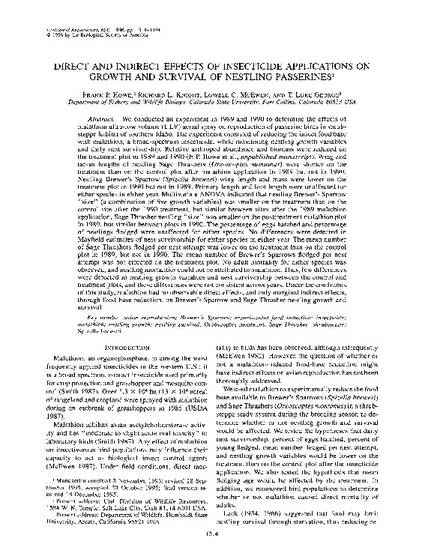
Article
Direct and Indirect Effects of Insecticide Applications on Growth and Survival of Nestling Passerines
Ecological Applications
(1996)
Abstract
We conducted an experiment in 1989 and 1990 to determine the effects of malathion ultra-low volume (ULV) aerial spray on reproduction of passerine birds in shrub-steppe habitat of southern Idaho. The experiment consisted of reducing the insect food base with malathion, a broad-spectrum insecticide, while monitoring nestling growth variables and daily nest survivorship. Relative arthropod abundance and biomass were reduced on the treatment plot in 1989 and 1990 (F. P. Howe et al., unpublished manuscript). Wing and tarsus lengths of nestling Sage Thrashers (Oreoscoptes montanus) were shorter on the treatment than on the control plot after malathion application in 1989 but not in 1990. Nestling Brewer's Sparrow (Spizella breweri) wing length and mass were lower on the treatment plot in 1990 but not in 1989. Primary length and foot length were unaffected for either species in either year. Multivariate ANOVA indicated that nestling Brewer's Sparrow size (a combination of five growth variables) was smaller on the treatment than on the control site after the 1990 treatment, but similar between sites after the 1989 malathion application. Sage Thrasher nestling size was smaller on the posttreatment malathion plot in 1989, but similar between plots in 1990.
Disciplines
Publication Date
1996
DOI
DOI: 10.2307/2269609
Citation Information
Frank P Howe. "Direct and Indirect Effects of Insecticide Applications on Growth and Survival of Nestling Passerines" Ecological Applications Vol. 6 Iss. 4 (1996) p. 1314 - 1324 Available at: http://works.bepress.com/frank_howe/11/
